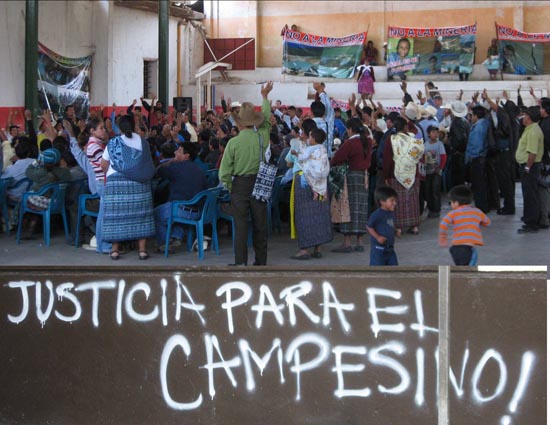|
As an International Studies major, I had the opportunity to visit Guatemala with an educational delegation led by Rights Action, a non-profit organization that promotes human rights in Central America.
We began our journey in Guatemala City where we learned the history of Guatemala and how transnational companies are taking advantage of rural, indigenous peoples and are resisting efforts for justice.
We heard from a massacre survivor who was only 11 years old when his family was killed and he was enslaved by a military official for two years. We also met with leading lawyers and activists who are combating injustices suffered by indigenous peoples on the national and international level.

Nueva Linda resistance. Photo by Rosie Worthen
We then visited Nueva Linda, where Hector Reyes - a local leader who belonged to the Landless Maya Workers Union - mysteriously disappeared in September 2003. Within weeks, Maya people from 22 nearby communities occupied Nueva Linda to call attention to his disappearance and the collective Maya struggle for arable land to feed themselves.
Guatemalan security forces carried out a violent eviction in Nueva Linda which left 12 people dead (see photos and video by James Rodriquez at http://mimundo-jamesrodriguez.blogspot.com/2007/09/nueva-linda-along-side-of-road.html.)
Four years after the disappearance of Hector Reyes and three years after the massacre, the Nueva Linda Movement for Justice continues its struggle through resistance living along the side of the road to Champerico.
 It's unanimous: no mine expansion. Photo by Rosie Worthen. |
Mining has caused deforestation, water depletion, destruction of homes, water and air contamination, respiratory problems, skin disease, hair loss, and other health problems, as well as repression, social breakdown and community division, according to local leaders.
The San Marlin mine affects many of the rural indigenous communities in Guatemala. The company is tearing down mountains and using cyanide leaching to extract tiny amounts of gold in the rock and then dumping the waste into the streams and rivers that these communities rely on to survive.
Lack of water is now common because the government gave permission for the mining company to use as much water as they want. The water used by the company in one hour can supply one indigenous family in that area for 23 years, according to local leaders.
It is estimated that one third of the national territory in Guatemala has been leased to mining companies. The real tragedy is that the land owned by these indigenous communities was leased away by the government without consultation or compensation.
UPDATE ON WATER CONTAMINATION
On September 15, 2008, the Latin American Water Tribunal examined the impact of mining on local communities. The hearings were held to document the harm and human rights violations caused by Goldcorp, Inc. in Guatemala.
Bogantes said the water tribunal will examine 10 cases of contamination caused by mining exploitation and water hoarding in Central America and Mexico. One of the cases concerns the contamination of the Tzalá River in the Cuilco River Basin, San Marcos, by the Montana Exploradora Mine (owned by Goldcorp Inc.)
______________________________________________________________________________
 Editor's Note:
Editor's Note: